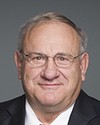That's class 4. After that, we basically bury the cost of the upgrade from class 3 to class 1 into the day-to-day training. The one that costs us the most is actually the $10,000.
I'll come back to the carbon tax. One thing that is interesting for me when I see a committee like this—and this is my first time.... It's very interesting to see that we have solutions in our pocket today that we can implement to solve the noise issue, to solve the carbon tax issue and to solve the training issue, but we cannot use them because we are either constrained by the regulatory constraints or constrained financially because of the nature of what we can actually get from our students; $85,000 is pretty much the maximum we will get from our students today.
Just by tweaking things around, we'll actually be able to solve Saint-Hubert's issue, and we'll be able to solve our pilot shortage and use those technologies. By using those aspects, such as the electric aircraft that I mentioned in my brief, which make less noise, the carbon footprint is gone.
If the Canadian government gives us the tools to actually implement that, then that works and we can actually find a solution there. However, if you corner us to a point where we can't move, then that's where we're going to need to ask to be removed from the tax or as an exemption on the tax issue for fuel, because we can't move and we can't train anymore. We have no way to play the financial game that we're playing.




